Animation Sensation: THE IRON GIANT: Brad Bird’s Robot Story With A Big Heart
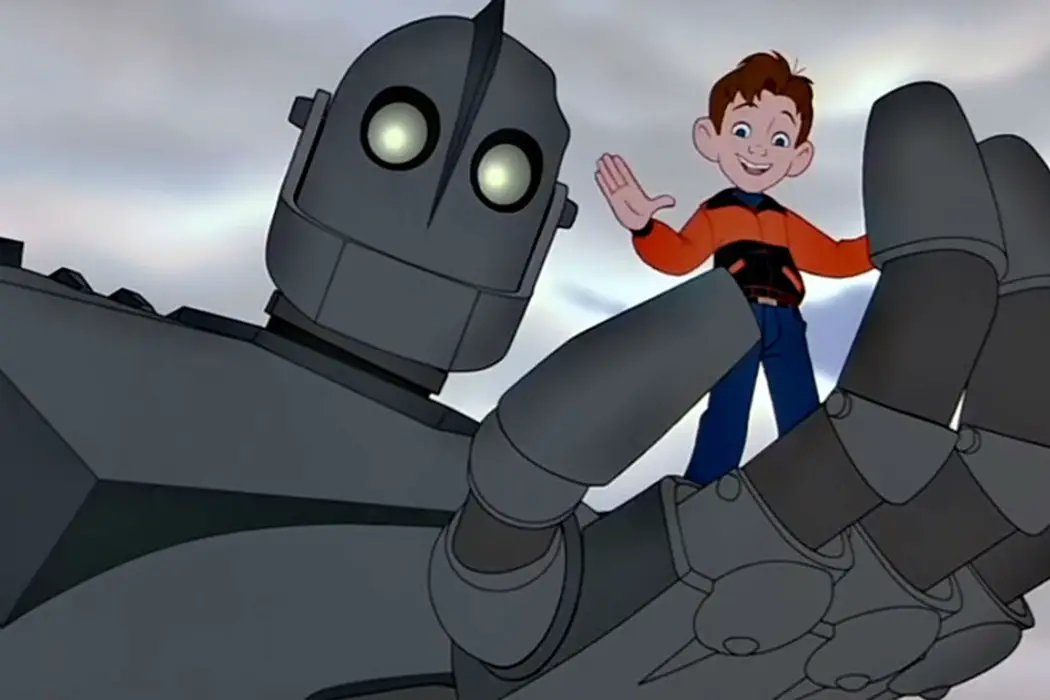
If there is one word that can sum up Dallas…
When it comes to mind, there is a method to the madness, and when it comes to animation, the gears are constantly turning. Lilo and Stich and E.T: The Extraterrestrial are two strikingly similar in terms of themes and characters. The obvious difference is that one is animated, and the other is live-action, respectively. Both films have to deal with a lonely child who resides in a broken home. Both children suffer from loneliness and bubbling anger within that is assuaged through an outside intermediary force that is extraterrestrial in origin. The alien-friend trope in films has become a staple, but neither of those films will be the focal point of discussion; they merely act as a method of catalyst for the true champion of this month’s feature of Animation Sensation: The Iron Giant.
Unlike both Lilo and Stitch and E.T: The Extraterrestrial, The Iron Giant was not a smash hit upon its premiere in 1999. While critically acclaimed and highly regarded by animation buffs, it has been relegated to being something of an afterthought in the mind of the film-going collective. But I am willing to go out on a limb and state that The Iron Giant takes the films’ themes as mentioned above and does them better and with actually more heart. Lilo and Stitch is a fine animated film, and E.T. continues to be a go-to staple for me, but there is something about the love put into The Iron Giant that makes it seem to resonate with me more. It utilizes the alien/kid friendship tropes and plays with them perfectly, allowing for a touching story of friendship to flourish. I am not ashamed to admit that The Iron Giant is one of the few films that actually made me cry, and here’s why.
When it comes to the titular Giant, less is more.
Voiced by Vin Diesel, the Giant has no name, and his backstory is given little to no explanation. When the Giant is introduced, he is a blank slate and portrayed as very childlike. Childlike is the keyword here, not childish. Childlike is someone who is filled with wonder, a sense of whimsy, awe, and curiosity about the world around them; all of the positive attributes of children, the endearing qualities. Whereas childish is all of the stress-inducing and negative aspects of childhood, the whining, entitlement, and obstinance make many adults shy away from being around children.
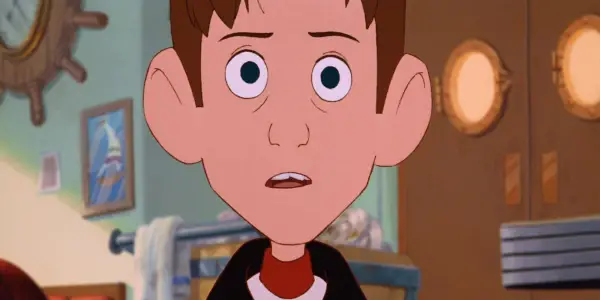
The titular Giant does not say much, but Brad Bird‘s skillful direction makes all of his emotions and thoughts shine through from his actions. Since films are a visual medium, using movement and gestures to tell the viewer how the Giant feels is where The Iron Giant shows its chops. This is an animated film where the makers followed the principle of “show don’t tell,” and whenever the Giant is on screen, he melts hearts because of his curiosity about the new world he has crash-landed on. Hogarth Hughes, the main boy lead of The Iron Giant, takes him in as if the Giant were some gargantuan puppy. A scene that exemplifies the fun nature of the Giant is when Hogarth is showing him some of his favorite silver-age comics. The Giant, sitting on his belly with his hands on his chin, like a toddler looking at a picture book, is in awe of the colorful comics, especially Superman, who he immediately resonates with and wants to emulate.
As the Giant learns more about Earth, this strange and beautiful world, he also learns morality and, in a touching scene, about death. When Hogarth and the Giant find a dead deer some hunters shot down. The Giant, overwhelmed by sorrow, becomes very depressed, and even though Hogarth is a child himself, he consoles the Giant by giving him a profound speech about how all things, sooner or later, must die. Upon which the Giant simply asks, “I…die?” A sad thought, which affects Hogarth and the Giant, but Hogarth believes, due to the feelings of the Giant, that he has a soul and that because of that, he will live forever. The Giant, gazing upon the starry night after such an existential discussion talks to himself: “Souls don’t die…”
Since the Giant says little, which seems to be a pattern with all of Vin Diesel‘s voice acting roles (I’m looking at you, Groot) Vin‘s naturally deep voice shows just enough vulnerability but also power. The Giant, although a machine that can cause great harm (which is revealed later in the film, with tremendous effect) is, at heart, a gentle soul and the perfect dichotomy to the energetic and talkative Hogarth — speaking of Hogarth.
Hogarth is one of the best child characters in a movie.
When I started this feature, I mentioned both movies, Lilo and Stitch and E.T., respectively. Both have similar themes of children who befriend non-human creatures from another world, and while Lilo and Elliot share being human children with Hogarth, I believe Hogarth is more of a likable character.
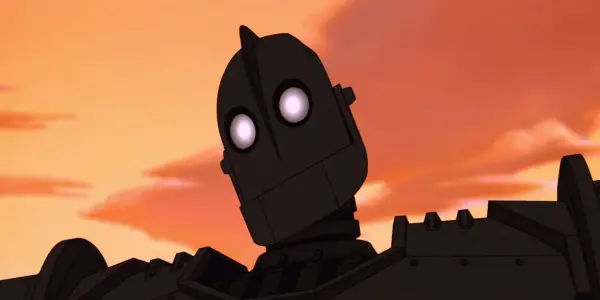
Hogarth does not fall into the same storytelling traps as the other two characters. Lilo and Elliot are lonely children who lash out at those around them because of their emotional pain. Right from the start of The Iron Giant, Hogarth is shown to be an unusual kid who seems to have very few friends, but the refreshing breath of air comes from the fact that he is okay with being alone and doing what he wants with his time. He is not lonely but instead content with his existence and instead of worrying about whether he fits in with the other kids, he is more concerned with reading the latest issue of The Spirit or watching cheesy 50s horror movies while sitting under a fort of blankets. This does not mean, however, he is afraid to make friends.
Hogarth has a penchant for making friends with outsiders and the so-called weirdos of society. Aside from 100-foot robots from space, he also befriends Dean, a junkyard man who is an artist on the side and an avowed beatnik. Anyone who has an inkling of 1950s American history knows that the Beatniks were the counter-culture artists and iconoclasts of their time. They usually kept to themselves and were presented in the media as a flighty bunch of pseudo-intellectuals and, at least when it came to the straight-laced mainstream society of the time, people to avoid company with or at least kept at an arms distance.
The relationship between Hogarth and Dean starts as a means to an end, a way for the Giant to find shelter and food since the primary source of sustenance for the gentle behemoth is eating metal. But as the film progresses, Hogarth views Dean as a friend, and Dean, in turn, begins to form a big-brother relationship with the young lad. For a time where McCarthyism was at its zenith, for Hogarth to befriend both a counter-culture man of the beat generation and a literal illegal alien, this went against the grain. (more of McCarthyism and American paranoia later)
One of the other aspects of Hogarth that bucks the trend of storytelling is his relationship with his mother. It is common in stories when a single mother raises a boy, he will inevitably turn out to be a renegade, get into trouble, and feel like an outcast or that he is missing something in life. While it alludes in the film that Hogarth’s father died in, more than likely, the Korean War, his father is never mentioned in the movie and Hogarth seems to get along fine with his supportive mother. Hogarth does get into trouble, but it never goes past anything that is usual childish shenanigans.
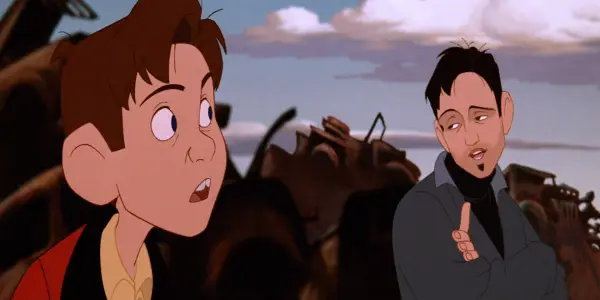
Hogarth feels like a balanced child, content with his own company, and unlike several other films of the same ilk that feature non-human friends, The Iron Giant is different. In many similar stories, the non-human friend character acts as a replacement for loneliness, a kind of savior of sorts for the child character–giving them the love and friendship that they desperately need to save them from themselves. In comparison, Hogarth’s friendship with the Giant is an augmentation, an add-on that improves his already fun life. As someone who was raised by a single mother and did not get into trouble, this is a breath of fresh air to see that not all boys who are raised by single mothers turn out to be troubled people.
Morality and McCarthyism
One of the standout aspects of The Iron Giant is its moral scope. Most films, animated or not, which are structured with a younger audience in mind have, in all honesty, rather trite moralism bandied about. “Always follow your heart,” or “good always wins,” or some of the platitudes thrown about like stale popcorn at a theater. The Iron Giant takes a more nuanced approach to how it handles its ideas, and the prominent philosophical stance it takes is that of the concept of self-determinism.
This is where some spoiler territory is about to be explored, so for those who want to enter The Iron Giant blind, it is recommended to watch the film before continuing. All warnings aside, in the film, it is later revealed that the Giant himself is a robot made for war from another planet and is, by design, comes from a line of giant robots sent to various planets throughout the galaxy to conquer and subdue worlds. At the beginning of the film, the Giant suffers from a mechanical form of amnesia, hence the fun-loving and gentle soul who would never harm a fly. Hints were given before the big reveal. Whenever the Giant is presented with any kind of gun, his eyes glow red and he is poised for attack. This was kept at bay due to Hogarth or other human friends such as Dean, snapping him back into reality, and despite the Giant’s natural inclination to be a walking war machine, the hulking machine with a heart feels guilt.
Hogarth, being the good friend that he is, tells the Giant that he can make a choice to be good, and he learns this from Dean when the two of them spend time together at Dean’s junkyard. Hogarth, in a humorous caffeine-induced rant, unloads some of his life’s problems onto Dean, who, with sagacious wisdom, tells Hogarth that everyone goes through difficulties but can choose to come out on top and not let life get the better of them. To paraphrase the beatnik, “you are, who you choose to be.”
With the traditional moralism stated earlier presented in most children’s films, this is a breath of fresh air. Telling youngsters that they have the will and reason to make choices in their lives is something that even a lot of adult films do not espouse. Most children’s stories give trite platitudes, but The Iron Giant tries to tell young audiences that everyone has a choice. Hogarth and the Giant have their issues they have to work through at times, but ultimately Hogarth chooses to be a good friend, and the Giant, even though his past is dark, decides to be heroic like Superman.
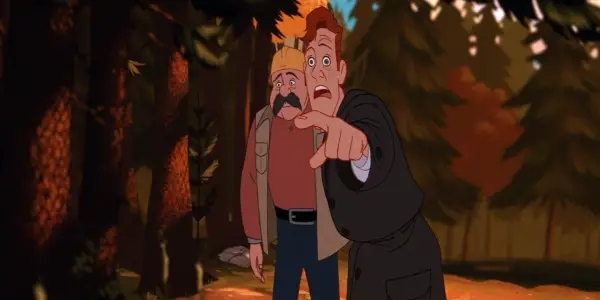
This is where the main antagonist comes in, and fortunately for the viewers at home, he is an entertaining one. Kent Mansley is a government agent sent in by the big army brass to investigate the strange goings-on that have been reported due to the Giant’s being on planet earth. He is paranoid, xenophobic, and obsessive but, as far as the early stages of the film, mostly a harmless pencil pusher who is more of a goofball than any serious threat. His antics, in the beginning, are some of the funniest of the film, primarily due to the voice acting of Christopher McDonald. He is the perfect blend of by-the-book-authority-figure interlaced with incompetent dorkiness. He is the opposite of the moral message of The Iron Giant since he lets his cold-war era paranoia get the better of him at all times. In his mind, the Giant, although he cannot prove such a creatures’ existence, is not “built by the Americans,” so it must be destroyed. He has as much unfounded fear of the Giant as he does something like Sputnik being launched because it’s an, in his words, “foreign satellite!”
The Iron Giant is not only a treatise on self-determinism and making the best moral choice despite one’s darker side but also an indictment against fearing others purely because they are different. The beauty behind this 50’s era fable is that The Iron Giant never takes the soapbox approach, unlike other family films with similar messages. It presents its ideas and allows the young ones in the audience to make up their mind about what is being said, connecting the dots. I love it when a children’s film does not insult the intelligence of its audience.
The nuance of the characterization does not just stop with the Giant and Hogarth but extends to side characters as well. General Shannon Rogard is the direct superior to Kent Mansley and acts as the foil to his paranoia. For many American films, having an old white guy who is a general in the United States army means that such a character is usually relegated to the status of a bull-headed, blowhard, the anti-hero of sorts. But The Iron Giant presents General Rogard as an intelligent man who is sickened by Mansley’s hyper-nationalistic tendencies and paranoia. The General views Mansley as someone worthy of ridicule, no matter how much Mansley states that everything he does is for the “good of the country.”
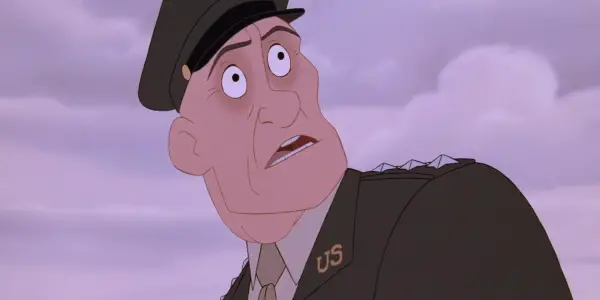
John Mahoney‘s gruff and tough voice aids in bringing the character to life, and while General Rogard can be a hard-ass and harsh at times, he is also fair and is willing to listen to reason. One such scene that showcases these qualities is when Dean is warning the general that the Giant only attacks when he is being fired on. The General takes heed of such warnings and tries to find a more diplomatic approach. In other films of such ilk as this one, many other generals would laugh off such a character as Dean, deriding him as a delusion peacenik, beatnik who needs to get his head out of the clouds. Much like the Giant himself, The Iron Giant shows us that there is more than meets the eye, even regarding a man of war. It all circles back to the moral idea behind the film that just because someone has the power to do whatever they want with such power, they can choose to be benevolent.
Tears were shed
I do not cry very often during films. This is not because I am a heartless person but because, like many other men, whether one likes to admit it or not, have been conditioned to view crying as a weakness. And yet, The Iron Giant turns me into a softie every time I watch, especially with the emotional doozie of an ending. I have not met many who have seen this film, but for all of the individuals I have met who have seen it, the consensus is the same: tears were shed. And most of the people who I have run across who viewed this movie have been men.
This is a film that can be enjoyed by all audiences regardless of gender. I watched this movie with my mom and it is one of her favorites. But I believe The Iron Giant is a film that explores the emotional core of men and boys, with male friendship being the film’s core. It is a film that stresses the importance of males to be in touch with their emotions and form bonds that are not based around machismo posturing but exploring feelings in a healthy way. Also, most of the male characters (aside from Kent Mansley) are some positive representation of a male archetype. Hogarth is boyhood with all of the confusion and wonder and joy that comes with it. Dean, starting as an aloof artsy type, still maintains his beatnik lifestyle but takes Hogarth under his wing and takes on the role of a wise mentor. General Rogard is the warrior archetype but not a vicious warlord, he is instead an intelligent protector and is not afraid to dole out justice towards the corrupt Kent Mansley. And Kent, the only antagonist of the film, is an example of what man should not be: a fearful and paranoid coward who abuses his power for the sake of his own goals.
Then the star of the show, the Giant, is pure power incarnate. He is big, bulky, and can be a literal weapon that can squash every tiny human if he so chooses. But instead, he is gentle, kind, and shows concern for all small things. He could conquer the world, but rather, he chooses to save it during the climax when, due to Kent giving an impulsive order to launch a missile to destroy the Giant, the giant flies up to the sky to sacrifice himself to save a little town filled with people that he loves.
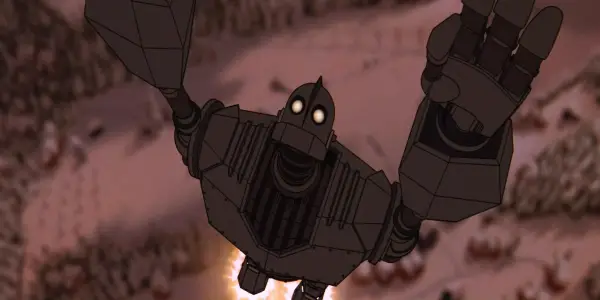
There is more that I could say about The Iron Giant, like how it was inspired by a strange children’s book called The Iron Man: A Children’s Story in Five Nights by the British poet Ted Hughes. Or I could extrapolate as to why the film was a box office failure. But any such discussion would be a pointless endeavor, and I strongly urge everyone, fans of animation or not, to pick up a copy and watch this classic film for yourself.
Oh, and I dare anyone to watch the ending of The Iron Giant and test to see if their eyes stay dry. I know I wasn’t able to.
So what do you think? Have you seen The Iron Giant? Is it as impactful as I am making it out to be, or am I looking at this movie with a nostalgia bias? Let us know in the comments below!
Release Date: August 6, 1999, United States
Does content like this matter to you?
Become a Member and support film journalism. Unlock access to all of Film Inquiry`s great articles. Join a community of like-minded readers who are passionate about cinema - get access to our private members Network, give back to independent filmmakers, and more.
If there is one word that can sum up Dallas Marshall, it would be weird. He is a strange fellow who is also a writer, anime nerd, and film buff who can also talk for hours about mythology and out-there literature. He has been sighted at local used bookstores perusing for horror books and manga. He has also written a book about Japanese animation called Anime Adrenaline! Which can be found on Amazon. You can also catch him on his own website at www.Dallasthewriter.com













